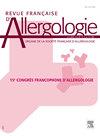老年性血管水肿:实际考虑
IF 0.3
4区 医学
引用次数: 0
摘要
与血管性水肿相关的挑战因患者年龄而异。在儿童中,最常见的是缓激素相关的遗传性血管性水肿(HAE)。当体征和症状不能唤起时,诊断可能是困难的,例如孤立的腹部危象,在没有家族背景的情况下。应迅速组织多学科团队管理,最好在专家中心进行管理,使儿童过上正常的生活,获得满意的发展。青春期往往以危机的频率和严重程度增加为特征,必须是病人在疾病管理方面获得授权的时期。但这也是一个不稳定和动荡的时期,可能会降低对治疗的依从性。由于雌激素分泌与HAE发作之间的关系,年轻女性患者必须讨论避孕。在成人中,随访和治疗没有任何显著特征。如果HAE在成年期出现,应考虑鉴别诊断,如获得性C1抑制剂缺乏,并应检测相关血液病(单克隆γ病或淋巴增生性综合征)。怀孕需要加强监测,因为在这种情况下会产生特定的风险。最后,在老年患者中,先前存在的HAE通常与其他合并症有关,这些合并症会干扰其发展,特别是由于药物摄入。攻击管理可能会变得更加困难,遵从性可能会降低。65岁以后发生HAE的情况很少见,因此诊断医源性血管性水肿(特别是与转化酶抑制剂有关)或卒中溶栓是很重要的。本文章由计算机程序翻译,如有差异,请以英文原文为准。
L’angiœdème à travers les âges : considérations pratiques
Challenges associated with angioedema differ with patient's age. In children, the most frequent one is bradykinin-related hereditary angioedema (HAE). Diagnosis might be difficult when signs and symptoms are not evocative, such as isolated abdominal crises, in the absence of familial context. Management by multidisciplinary team should be organized rapidly, preferably in an expert center, to allow children living a normal life and experiencing satisfactory development. Adolescence, often characterized by an increase in frequency and severity of crises, must be the period of patient's empowerment in disease management. But it is also a period of instability and turbulences with a possible decreased compliance to treatment. Contraception must be discussed in young female patients due to the relationship between estrogen secretion and HAE attacks. In adults, follow-up and treatment are pursued without any remarkable feature. If HAE appears during adulthood, differential diagnoses should be considered, such as acquired C1 inhibitor deficiency, and associated hemopathies should be detected (monoclonal gammopathy or lymphoproliferative syndrome). Pregnancy requires increased surveillance because of specific risks arising in this situation. Finally, in elderly patients, preexisting HAE is often associated with other comorbidities that can interfere with its evolution, especially because of drug intake. Attacks management may become more difficult and compliance may decrease. Occurrence of HAE after 65 years of age being exceptional, it is important to diagnose iatrogenic angioedema (related in particular to conversion enzyme inhibitors) or thrombolysis of a stroke.
求助全文
通过发布文献求助,成功后即可免费获取论文全文。
去求助
来源期刊

Revue Francaise d Allergologie
Medicine-Immunology and Allergy
自引率
33.30%
发文量
349
期刊介绍:
La Revue Française d''Allergologie : un véritable forum pour faire connaître des travaux originaux et permettre la diffusion de l''information auprès de toutes les spécialités concernées par les pathologies allergiques. La Revue Française d''Allergologie (8 numéros par an) est au carrefour de nombreuses spécialités - dermatologie, pédiatrie, ORL, pneumologie, ophtalmologie, médecine interne - qui, toutes, ont à traiter des maladies allergiques. Les symptômes des allergies fondés sur des mécanismes communs sont le plus souvent associés et se succèdent chez un même patient. En forte progression depuis 20 ans, les maladies allergiques sont dans l''attente de perfectionnements et d''avancées thérapeutiques qui permettront aux nombreux patients qui en sont atteints de mieux vivre avec leurs allergies. La Revue Française d''Allergologie se veut donc un véritable forum de discussions et d''échanges entre tous les spécialistes confrontés aux pathologies
 求助内容:
求助内容: 应助结果提醒方式:
应助结果提醒方式:


